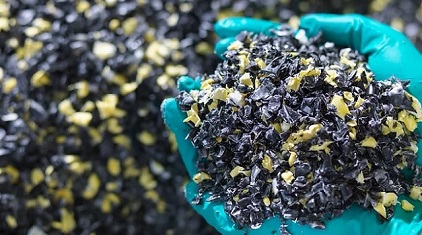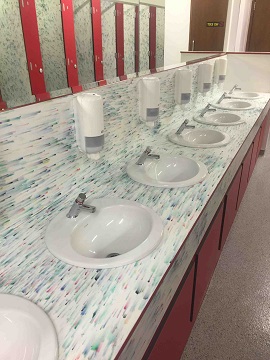 NATIONAL REPORT—U.S.-based RegenoPlast Materials LLC is distributing Storm Board, a replacement for plywood and wood fiber boards. Storm Board, comprised of 100 percent post-consumer and post-industrial mixed plastic waste, is currently made in the U.K. by Storm Board LLP.
NATIONAL REPORT—U.S.-based RegenoPlast Materials LLC is distributing Storm Board, a replacement for plywood and wood fiber boards. Storm Board, comprised of 100 percent post-consumer and post-industrial mixed plastic waste, is currently made in the U.K. by Storm Board LLP.
According to RegenoPlast Materials’ Chuck Mills, Storm Board was first introduced in Europe in 2011 and is comparable in size to plywood—a little larger than 4’ by 8’. Storm Board excels in wet environments, unlike wood-based products, and is impenetrable to rain and moisture. It will not rot, is resistant to microbial action, and is tough and versatile with a lower lifetime cost than marine grade or pressure treated wood products. Storm Board contains plastics that are difficult, if not impossible, to recycle. The Storm Board manufacturing process overcomes these challenges.
“It can be used anywhere where plywood is being used,” Mills says. “You won’t have the rigidity of plywood and it adds fire resistance.” It can be nailed, glued, or screwed.
Waste Raw Materials Cleaned, Granulated
 In the creation of Storm Board, waste raw materials are cleaned and granulated and applied in layers within a molding machine called a Quad Pod. The Quad Pod heats the mixed plastic waste raw materials in the mold to form a mechanically strong, light, and versatile panel. Once cooled, the Board is removed and the process starts anew.
In the creation of Storm Board, waste raw materials are cleaned and granulated and applied in layers within a molding machine called a Quad Pod. The Quad Pod heats the mixed plastic waste raw materials in the mold to form a mechanically strong, light, and versatile panel. Once cooled, the Board is removed and the process starts anew.
Recyclable Storm Board can be made into furniture, used in wall or countertop applications in public or guestroom bathrooms, for compost bins, recycling containers, concrete form work, and much more. It is available in many finishes and colors. “It can be colored but it is not a solid color,” Mills says. “It will always look speckled.” There are many coatings from leather look to brushed metal or even slate.
Storm Board has a smooth skin and a honeycomb core and is also available with a 70 percent plastic packaging waste/30 percent used coffee grounds mix. Print graphics can be applied to the surface to create innovative custom-made designs. A new product is coming that will have an underlying layer of fiberglass.
Used in First Net Zero Carbon McDonald’s in U.K.
At the first net zero carbon McDonald’s in the U.K., storm boards were used in the roof structure. The McDonald’s opened last December.
At the end of its life, up to 20 percent of the old board can be used in new Storm Board.
Why is it important to find new uses for plastic waste? Only 14 percent of plastic packaging is collected for recycling. When additional losses in sorting and reprocessing are factored in, only 5 percent of material value is retained for subsequent use. Plastics that do get recycled are mostly recycled into lower value applications that are not again recyclable after use. Each year, at least 8 million tons of plastics leak into the ocean. In a business-as-usual scenario, the ocean is expected to contain 1 ton of plastic for every 3 tons of fish by 2025, and by 2050, more plastics than fish (by weight).
Glenn Hasek can be reached at greenlodgingnews@gmail.com.






